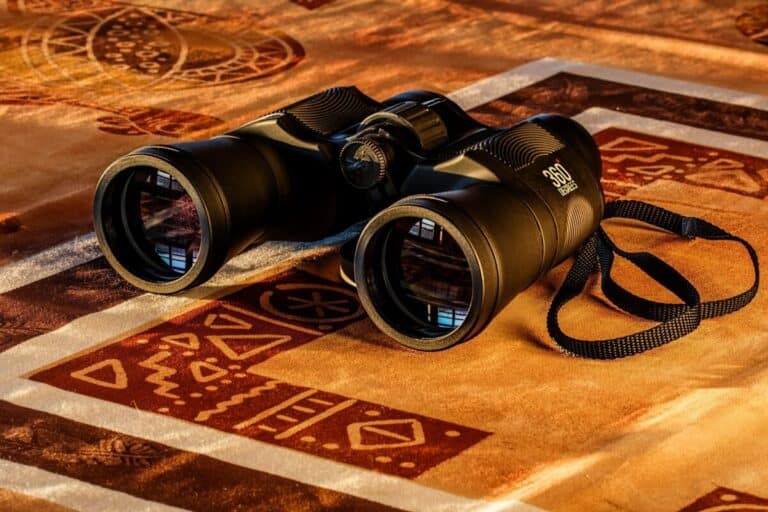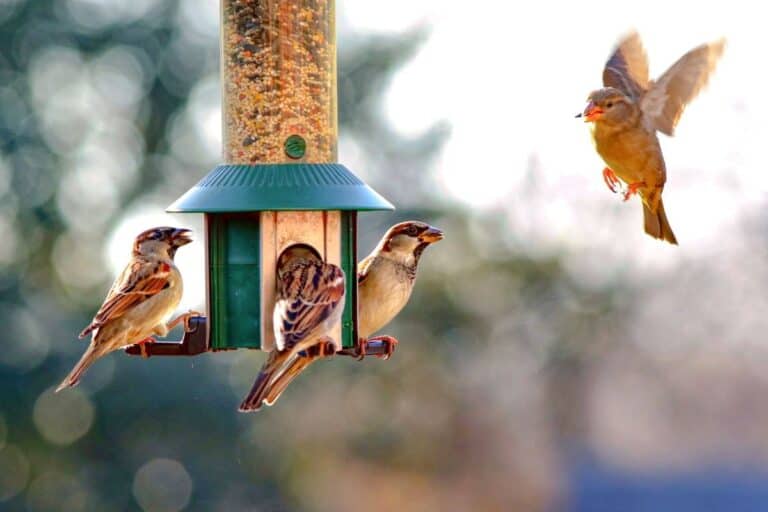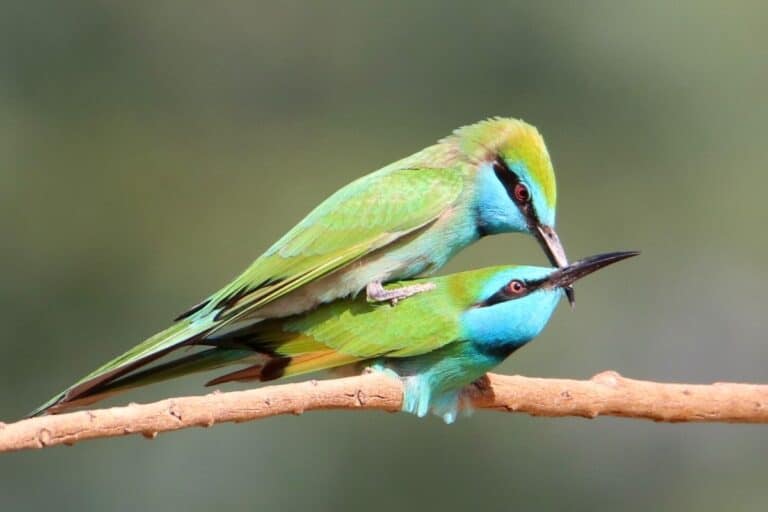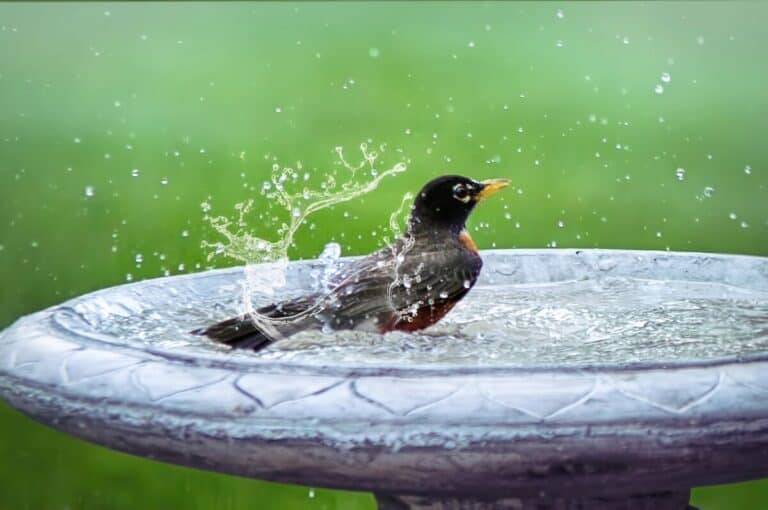17 Common Birds in Singapore: The Complete Guide
We’re reader-supported; we may earn a commission from links in this article.
Singapore is home to an incredibly large variety of bird species!
From the iconic Oriental Pied Hornbill and majestic Brahminy Kite to the acrobatic White-bellied Sea Eagle and inquisitive Lineated Barbet, here’s a look at some of the most common birds you can expect to see in our little Island City.
Let’s get into it!
What are some Common Birds in Singapore?
Singapore has many common birds that can be easily spotted in both urban and rural environments.
Here is a list of the most abundant birds you might see when exploring Singapore:
1.Oriental Pied Hornbill (Anthracoceros albirostris)
The Oriental Pied Hornbill is a large bird, easily identified by its black and white bill.
They are usually seen in pairs or small groups in open wooded areas and can be spotted flying from tree to tree, searching for food.
Its loud, distinctive call makes it easy to locate in the jungle.
2. Brahminy Kite (Haliastur Indus)
The Brahminy kite is a medium-sized bird of prey and can be found almost everywhere in Singapore, perched atop trees and scavenging for food.
It has a white head and chest with a reddish-brown back and wings, and its hooked beak is yellow in colour.
3. White-bellied Sea Eagle (Haliaeetus leucogaster)
The White-bellied Sea Eagle is a majestic bird of prey that can often be seen soaring high above the skies of Singapore, where they search for fish or other small animals to feed on.
They have pale grey wings and a white head, chest, and belly, with dark brown eyes.
4. Lineated Barbet (Megalaima lineata)
The Lineated Barbet is a small to medium-sized bird found in forests and gardens across Singapore.
It has bright red plumage on its head, back, and wings, with black stripes running across its body.
It is usually seen in pairs and has a loud call that can be heard from far away.
5. Common Myna (Acridotheres tristis)
The Common Myna is one of Singapore’s most easily spotted familiar birds, identifiable by its dark brown body, bright yellow beak, legs, and eye-patch.
This common bird known for its adaptability and is commonly seen in urban areas, parks, and gardens.
6. Javan Mynah (Acridotheres javanicus)
The Javan Mynah, often mistaken for the Common Myna due to their similar appearance, has a distinctive tuft of feathers on its forehead.
Its body is mostly black, with a striking white undertail. They are just as adaptable as their common cousins and equally at home in urban environments.
7. Asian Koel (Eudynamys scolopaceus)
The Asian Koel is a large-sized bird mostly seen in woodlands and urban gardens.
Males have glossy black feathers, while females sport a mix of brown and white speckled plumage.
Known for their distinctive, loud call, they are a common addition to Singapore’s morning chorus.
8. Yellow-vented Bulbul (Pycnonotus goiavier)
The Yellow-vented Bulbul is a small common resident bird found in gardens and parks across Singapore.
This bird is easy to identify, with a brownish-grey body and a bright yellow patch beneath its tail. They are known for their melodious song, which is a delightful addition to Singapore’s natural soundscape.
9. Olive-backed Sunbird (Cinnyris jugularis)
The Olive-backed Sunbird, known for its vibrant colors, is a frequent sight in Singapore.
The male is especially distinctive with its iridescent blue chest, belly, and olive-green back, while the female is primarily olive-brown.
They often flit about in gardens and parks, sipping nectar from flowers.
10. Spotted Dove (Spilopelia chinensis)
The Spotted Dove is a common sight in Singapore, with its greyish-pink body, white-spotted black collar, and long, broad tail.
These birds are found in woodlands, gardens, and parklands, and their soothing cooing sounds are a common part of the local soundscape.
11. Red Junglefowl (Gallus gallus)
The Red Junglefowl, the wild ancestor of the domestic chicken, is another bird that’s common in Singapore.
Males sport a vibrant mix of colors – a scarlet comb and wattle, white ear patches, yellowish-olive body, and dark tail, while females are a more subdued brown. The crow of the Red Junglefowl is a familiar sound in rural and semi-urban areas of Singapore.
12. Collared Kingfisher (Todiramphus chloris)
The Collared Kingfisher is a medium-sized bird that can be found near coasts, particularly in mangrove areas. Its striking blue plumage, white chest and collar, and stout, dark bill make it an eye-catching sight.
They’re known for their loud, distinctive call and ability to catch and eat a variety of prey, including fish, insects, and small reptiles.
13. House Crow (Corvus splendens)
The House Crow, with its glossy black plumage and grey neck, is one of the most commonly seen birds in urban areas of Singapore.
These intelligent Singapore birds are known for their adaptability and can often be seen foraging in groups, particularly in areas with food waste.
With such a rich diversity of avian life, Singapore is a bird-watcher’s paradise!
Originating from the Indian subcontinent, this introduced species was accidentally introduced into Singapore in the late 1940s.
With their adaptability and omnivorous diet, they have since made Singapore their home, often seen congregating in large numbers around food sources.
However, their aggressive behaviour and rapid population growth have affected native bird species, leading to ongoing control measures.
14. Pink-necked Green Pigeon (Treron vernans)
The Pink-necked Green Pigeon is a vibrant, multicoloured bird that adds a dash of color to the skies of Singapore. Males are especially dazzling, with a pink neck and lower breast, orange belly, and green wings, while females are a more subdued green. They are fruit eaters and can often be spotted on fruit trees, feasting on figs and berries.
15. Asian Glossy Starling (Aplonis panayensis)
The Asian Glossy Starling, a common sight in Singapore, is a medium-sized bird known for its striking all-black, glossy plumage that shimmers in sunlight.
The adult’s eyes are a distinctive bright red, while the juvenile birds have dark eyes.
Though primarily fruit-eaters, these adaptable birds also eat insects and nectar.
They are gregarious in nature, often seen in large, noisy flocks high in trees or on overhead wires.
In urban areas, they’ve successfully adapted to human environments, and they’re known to nest in holes in buildings.
Their loud, varied calls are a familiar sound in Singapore’s soundscape.
16. Black-naped Oriole (Oriolus chinensis)
The Black-naped Oriole is a striking bird that is easily recognisable in Singapore.
With its vibrant yellow body and contrasting black eye-stripe and nape, it certainly stands out in the lush green landscapes of the city.
These birds are predominantly fruit eaters but also include insects and small animals in their diet.
Their call is a distinctive, melodious, fluting sound that can be heard echoing through the trees.
They are commonly sighted in Singapore’s parks and forests due to their preference for wooded areas.
The Black-naped Oriole, with its contrasting colours and melodious call, adds to the vibrant avian diversity of Singapore.
17. Blue-crowned Hanging Parrot (Loriculus galgulus)
The Blue-crowned Hanging Parrot is another colourful specimen in Singapore’s bird kingdom.
Despite its relatively small size, this bird captures attention with its vibrant green body, blue crown, and red rump and throat. Named for their unique resting behaviour, these parrots sleep upside down, reminiscent of bats.
They predominantly feed on fruits, especially liking the ripe ones, but also include blossoms and seeds in their diet.
Their strong beaks are well-adapted to crack open hard-shelled fruits.
The soft, musical whistles of the Blue-crowned Hanging Parrot add a serene note to Singapore’s dawn and dusk chorus.
They favour wooded areas and are often sighted in forests, parks, and even residential areas with abundant trees.
The Blue-crowned Hanging Parrot, with its unique behaviours and vibrant colouration, is a delightful part of Singapore’s rich birdlife.
Bird Photography Tips and Etiquette
When photographing other birds in Singapore, it’s important to remember a few tips and etiquette.
Keep your distance from the birds while photographing, as they fly away if approached too closely.
Also, be aware of their habitats and don’t disturb their nests or other perching areas.
Finally, use the appropriate equipment, such as a long lens or tripod, to get clear and sharp photographs.
So what are you waiting for? Grab your camera, and let’s explore Singapore’s avian treasures!
Where to find birds in Singapore?
Some of the best places to spot them are Pulau Ubin, Sungei Buloh Wetland Reserve, and Bukit Timah Nature Reserve. Many can also be seen in parks and gardens around the city.
So take some time out from your hectic schedule to explore Singapore’s birdlife. Whether it’s a morning stroll in your local park, or an island excursion to spot the great diversity of birds that call Singapore home, you won’t be disappointed!
Frequently Asked Questions
What is the best time to watch birds in Singapore?
Birdwatching can be done throughout the day. However, birds are typically most active during the early morning or late afternoon. These are the best times to observe them as they feed and interact.
What should I bring for bird watching?
Bring a pair of binoculars for a closer look at the birds. A field guide can also be useful for identifying different species. Don’t forget to wear comfortable clothing suitable for the weather, and bring along a hat and sunscreen to protect against the sun.
Is it possible to feed the birds?
Feeding wild birds is generally discouraged as it can disrupt their natural diet and behavior. It’s best to observe them from a distance and let them find their own food.
What should I do if I come across a bird’s nest?
If you find a bird’s nest, do not disturb it. Birds are protective of their nests and may abandon them if they feel threatened. Keep your distance and observe quietly.
Are there any endangered bird species in Singapore?
Yes, several bird species in Singapore are considered endangered. These include the Straw-headed Bulbul and the White-bellied Woodpecker. Efforts are currently underway to protect these species and their habitats.
Join a Guided Birdwatching Session with the Nature Society
Are you ready to take your birdwatching journey to the next level?
Why not join a guided birdwatching session with the Nature Society? These sessions, led by experienced birdwatchers, provide an excellent opportunity to learn from experts in the field.
You’ll be able to observe birds in their natural habitat, learn about their behavior, and get tips on how to identify the diverse species found in Singapore.
Participants of all ages and experience levels are welcome, making it a perfect family-friendly activity. These sessions are usually held during the early morning hours when the birds are most active, enhancing your birdwatching experience.
Conclusion
Are there any other common birds in Singapore that you’ve seen?
Send us an email! We’d love to hear from you.
If you’re looking for more info about the birds of Singapore, be sure to check out our website, where we have a comprehensive guide to the different species and their habitats.
Happy birding!

Justin Chia
Justin is the founder and author of Birding Outdoors. He is a Nanyang Technological University (NTU) alumnus with a Bachelor of Biological Sciences and a former data analyst.
Now, Justin runs the Birding Outdoors blog full-time, hoping to share his deep love for birds, birding, and nature with others.
To unwind, Justin enjoys gaming and reading.


![What Is A Lifer In Birding? [ANSWERED! + Usage Examples]](https://birdingoutdoors.com/wp-content/uploads/2021/03/pexels-photo-6272236-768x512.jpeg)



![How Long Do Birds Take To Find A New Feeder? [ANSWERED!]](https://birdingoutdoors.com/wp-content/uploads/2021/06/indigo-3590765_1280-768x512.jpg)